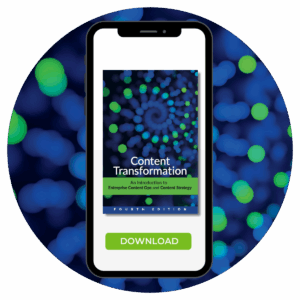CompTIA accelerates global content delivery with structured learning content
CompTIA plays a pivotal role in the global technical ecosystem. As the largest vendor-neutral training and credentialing organization for technology professionals, CompTIA creates career-advancing opportunities across a wide range of disciplines—cybersecurity, infrastructure, data, and more.
With the support of Scriptorium and other partners, CompTIA consolidated fragmented workflows into a unified ecosystem for structured learning content. The transformation has improved production efficiency and allows CompTIA to deliver global content without pausing ongoing content production. Additionally, it allows instructional designers to invest in compelling learning experiences instead of spending their time manually formatting content.
The challenge of content unification
CompTIA manages a growing portfolio of digital content, certification training materials, and training resources. They needed robust, scalable content operations to keep pace with evolving learning needs and market demands. CompTIA evaluated several traditional learning content systems, but none of them met CompTIA’s stringent requirements for authoring, flexibility, automation, and extensibility. By the time CompTIA reached out to Scriptorium, CompTIA had already identified DITA XML as a potential framework to address their requirements. CompTIA then underwent a major organizational shift.
“We needed to scale our operations in creating localized content. We had a particular need in Japan where we were trying to efficiently localize our certification training and could not figure out how to efficiently translate our base ebook content into Japanese. That was when we first looked at how to actually reuse materials. Then, while we were digesting that, CompTIA acquired another company.”
— Becky Mann, Vice President of Content Development at CompTIA
All quotes from Becky Mann are from the transcript of the DCL Learning Series webinar, How CompTIA rebuilt its content ecosystem for greater agility and efficiency.
CompTIA faced the daunting tasks of managing multiple content systems, siloed editorial teams, varying delivery formats, and lengthy time-to-market challenges—all while maintaining a seamless learner experience. Pausing production was not an option.
The collaborative approach to building structured learning content
To address these challenges, CompTIA decided on a structured learning content approach with the guidance of three key partners.
Scriptorium provided:
- Content strategy consulting. We outlined a structured content model and provided system recommendations based on CompTIA’s needs.
- Implementation support. We turned the content strategy plan into action, assisted with the migration process, and customized CompTIA’s chosen content management system.
- Systems training. We delivered training for CompTIA’s new environment and provided ongoing knowledge transfer on new customizations.
Data Conversion Laboratory (DCL) migrated CompTIA’s legacy content from multiple sources into DITA. Heretto provided a component content management system (CCMS) for CompTIA to author, manage, reuse, and deliver content at scale.
Additionally, CompTIA’s newly merged teams developed a collaborative mindset that contributed to the project’s success. The partnerships among CompTIA and the three vendors gave CompTIA the planning, infrastructure, tools, and implementation support it needed to restructure its content ecosystem while maintaining ongoing content production.
We were two new groups brought together. The nice thing about working with Scriptorium is that it allowed us to have a mediator to help us have conversations that strengthened our whole team. Both groups had this commiseration of, “Oh, your system is frustrating, too!” We were able to see each other’s pain points and focus on, “Okay, we know where our pain is. Where do we move forward? How do we make this better for all of us, gain efficiencies, and add value to our work?” Instead of, “Well, I need to adapt all my things to your way,” both teams were adapting. I think that was a really valuable part of the relationship.
— Becky Mann
Transforming CompTIA’s content operations
Scriptorium defined a content operations roadmap built on centralized content management and structured authoring with DITA, which included:
- Content model
- Content audit and toolset inventory
- System architecture
- Software recommendations
- Legacy content migration
CompTIA also had unique and complex delivery requirements. First, they have an internal learning management system (LMS). An LMS drives the learning experience. It is where learning content is published, how learners interact with the learning content, and where learner records are stored.
CompTIA needed to deliver learning content to their internal LMS and wanted flexibility to deliver content directly to other external LMSs. Additional output requirements included PDF and lab simulations.
Content model
Because of the requirement for output to multiple LMSs, the need for content reuse, localization requirements, and more, Scriptorium confirmed CompTIA’s initial assessment that DITA would be a good option for their new content model. We then provided some additional context:
- DITA has an add-on layer for learning content called the Learning and Training specialization (L&T), which provides components for lessons, lesson objectives, assessments, and other learning content. Scriptorium recommended using the L&T layer to align with CompTIA’s requirements. Scriptorium extended the L&T specialization with additional assessment types, lab and simulation topic structures, robust objective handling, and more.
- Scriptorium eliminated (“constrained out”) unnecessary elements and attributes to simplify the authoring experience.
Content audit and toolset inventory
CompTIA produces the following types of content:
- Text-based lessons
- Lab simulations
- Live Lab Activities using virtual machines
- Interactive HTML objects
- Assessment questions
- Videos
- Images
(CompTIA is known for producing certification exams, but those are handled by a different group and were out of scope for this project.)
To complete the content audit and toolset inventory, Scriptorium reviewed how each content type was created, reviewed, approved, delivered, and updated. We also reviewed the challenges and pain points content creators faced, as well as the goals the CompTIA team had for improving content development processes. We compiled a list of CompTIA’s goals for its text-based content:
- A unified content repository that served as a single source of truth
- An end-to-end system for authoring, reviewing, and publishing content
- The ability for multiple authors to work on the same content at the same time
- A modular content structure that would allow content creators to mix and match content chunks and assets
- The ability to reuse content (authors estimated that 25% of the text-based content could be reused)
- The ability to produce student and teacher versions of a course through fully automated processes
- A robust workflow for reviewing and approving content with automated email notifications
- The display of reporting, data analytics, and customer feedback alongside the content source
- The ability to identify and search for content according to:
-
- Its intended audience
- Where and how it is used
- How it relates to other content
- What has changed since the previous version
-
Additionally, CompTIA had long-term goals for its text-based content:
- Scaling up content development processes as the organization’s audience and product offerings grow
- Spending more time on content creation and innovation (and less time on content fixes and manual tasks)
- Working collaboratively across teams instead of in separate silos
- Introducing unified language, terminology, and style across all content
System architecture
To support content reuse, versioning, and localization, we recommended that all text content be authored in DITA. Most CompTIA content creators needed a user-friendly web-based editor. Power users could use Oxygen XML Editor for tasks such as bulk-editing metadata and complex search and replace operations.
Non-text assets would be authored in external applications, such as Adobe Illustrator or Photoshop for images, Adobe Premiere or Final Cut Pro for videos, and Microsoft PowerPoint for storyboarding and animations.
Additionally, CompTIA’s translation management system (TMS) was integrated with the CCMS to facilitate seamless source translation and multilingual publishing.
New system architecture for CompTIA
Software recommendations
After completing the content model, content audit, and tool inventory, Scriptorium began evaluating candidates for a DITA-based CCMS.
CompTIA’s baseline system requirements included:
- Open architecture based on DITA
- Support for DITA specialization
- Support for metadata and taxonomy
- Ability to publish out to HTML, PDF, and other formats and to customize the publishing pipelines to meet CompTIA requirements (such as custom HTML class selectors)
- Integration with a translation management system
- API support to connect the CCMS to other learning systems
- Support for content reuse at the topic, paragraph, and sentence level
- Support for general content management, such as keeping track of content changes, versioning, and assembly of courses from smaller components
Additional considerations:
- Authoring experience
- Web-based and offline editors
- Access to other systems, such as a digital asset management (DAM) system
Based on these requirements and other considerations, the CompTIA team decided on the Heretto CCMS for their structured learning content.
Legacy content migration
To prepare CompTIA’s content for the migration to the Heretto CCMS, CompTIA needed to convert its legacy content from its original XML and HTML formats into DITA.
The primary considerations for the conversion effort were automating the conversion process and handling reusable content. The process of converting content from its source formats to DITA involved:
- Content modeling. Scriptorium helped CompTIA decide how to tag its content using base DITA and L&T components, then set up the CompTIA content model as a DITA specialization.
- Creating conversion rules. Scriptorium mapped the structures in the existing XML and HTML content to their equivalents in DITA. We documented and explained these mappings. DCL used the mapping document as they built their conversion rules.
- Automated conversion. DCL automated the conversion of the content from the old structure to the new structure.
CompTIA’s legacy tools lacked content reuse capabilities, forcing authors to copy and paste content. This process created numerous versions of similar topics, making updates cumbersome and slowing localization. The new content model supports reuse to prevent future duplication, but existing duplicates still posed a risk. CompTIA needed to identify and eliminate duplication to ensure only one copy was brought into the new system.
To avoid converting duplicated content, Scriptorium, DCL, and CompTIA relied on:
- Author expertise. Authors knew where they frequently or recently duplicated content.
- Technology solutions. DCL’s Harmonizer software identifies duplicated material at different levels, from entire documents to individual sentences or phrases. For this project, DCL set up Harmonizer to find complete and partial text matches, which allowed CompTIA to locate exact copies and content that was copied and slightly rewritten.
The results
Today, CompTIA’s source content is stored and managed in a centralized repository, eliminating the recurring production headaches with redundant content. Instructional designers no longer spend time on formatting and file management—instead, they focus on crafting better learning experiences.
Now we’re going to start seeing the true benefits of working in DITA, which is what I’m most excited about. We can maintain our content easily and focus on where things are changing instead of converting, rearranging, or recopying content. I’m excited to see how our efficiencies gain as we move into our refresh cycle.
— Becky Mann
CompTIA’s key results include:
- Centralized content ecosystem. Source content for CompTIA’s training is now managed in the Heretto CCMS platform, simplifying ongoing content creation, maintenance, and publication.
- Content reuse. Instead of copying and pasting, reusing content is now standard practice.
- Unified content experience. The DITA-based system produces consistent formatting and output across multiple channels.
- Reduced time to market for localized content. The shift to automated, push-button formatting eliminated a bottleneck in the localization process.



